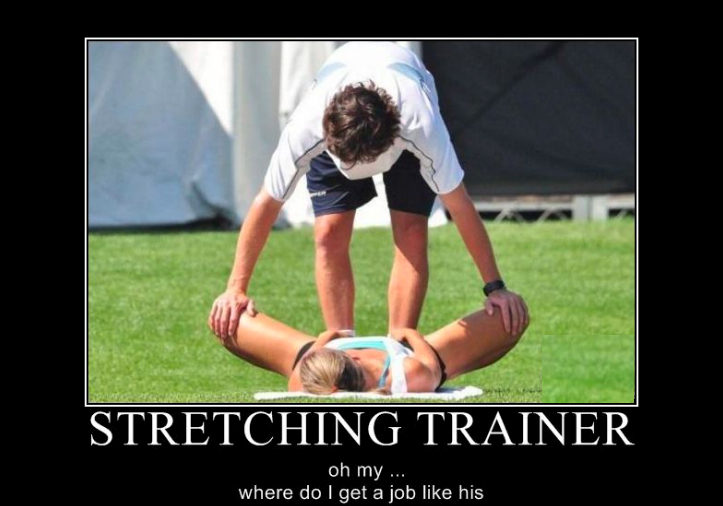Why Stretching May Be Bad Before a Workout
SO I get a copy of the NSCA’s two journals delivered to my door whenever they get published, but don’t get too jealous of this fact, seeing as how I pay for it every year. Most of the time the Research-oriented publication spends a butt-load of time talking about cycling for some reason, as well as a bunch of other stuff that doesn’t apply to anything I’m doing or any clients I’m working with. It’s pretty much mandatory reading for insomniacs most of the time. However, every now and then there’s a gem produced that makes it all worth while.
I felt this way when the recent issue came across my desk, and an article inside was titled Acute effects of Two Different Stretching Methods on Local Muscular Endurance Performance. In other words, “should I stretch before I get my crush on at the gym, and if so what will make me get all jacked up the bestest!!???”
Here’s the dealio. There’s a lot of talk around the industry about static stretching. Some, like Mike Boyle, believe it’s incredibly important to athletic power and performance variables, and can back it up with anecdotal evidence from his athletes as well as research to boot. I would expect nothing less from the Godfather. Others feel that static stretching beforehand is akin to giving someone a hammer and telling them to swing away at your knees, spine, and any other body parts you value.
 So this article kinda intrigued me, as there hasn’t been a school of thought that I’ve completely bought into as of yet. This was actually a cool test, as they took 15 people, checked out their 1 rep max, and then saw how many reps the could complete on a bench press and leg extension with various percentages of their max. They set up three groups: a no-stretch group, a static stretch group, and a PNF stretch group, which was more like CRAC stretching than classic PNF stretching through spiral diagonal planes of motion. They checked max reps possible at 40%, 60% and 80% 1 rep max and checked to see which group had the best results.
So this article kinda intrigued me, as there hasn’t been a school of thought that I’ve completely bought into as of yet. This was actually a cool test, as they took 15 people, checked out their 1 rep max, and then saw how many reps the could complete on a bench press and leg extension with various percentages of their max. They set up three groups: a no-stretch group, a static stretch group, and a PNF stretch group, which was more like CRAC stretching than classic PNF stretching through spiral diagonal planes of motion. They checked max reps possible at 40%, 60% and 80% 1 rep max and checked to see which group had the best results.
So guess what happened??
The no-stretch group won the battle hands down in both tests at all intensities. The PNF group was hugely affected. Static stretching didn’t produce a significant difference in power compared to the no-stretch group, however, it also didn’t produce any benefit to performance, which would beg the question “why would you actually stretch before strength training??”
So if we were to take this information and use it to design a program for someone looking to get stronger, how would we use it?? Well, if we took this ball and ran with it, we’d give up stretching prior to working out, as it doesn’t seem to improve performance versus not stretching. Since it doesn’t help, there isn’t any use for it, so let’s turf it.
So I’m sure you’re also thinking “Well what about foam rolling or active dynamic flexibility??” Well, in another article, the researchers showed foam roller work reduced fatigue and soreness compared with performing a plank exercise, but had no impact on performance. This means that since the participant wasn’t as sore, they could potentially work harder during their workouts and get more adaptation over the long-term.
So how do you use this information?? Well, let’s take for example a common workout flow that I use with a lot of my clientele:
General warmup and cardio
Foam rolling
Active mobilization of identified weak joints
Strength, conditioning and skill-based work
Static and PNF stretching at the end of the workout
And for your information, my arm tattoo is a rope with a knot in it, because I’m waaaaaay more bad-ass than barbed wire. You get more done with rope, and that shit looks so much more awesome.
So in conclusion, if you’re looking to get your swole on in the gym or start tearing up the track and running like Flo-Jo, static stretching won’t obliterate your muscles and cause performance to drop like a rock, but if you do more in-depth stretching before you workout, like PNF, you may be a hurting unit under the bar. Then everyone will mock you and your flaccid muscles. No one will talk to you, except old dudes in shortie shorts who try to tell you that you shouldn’t put so much weight on the bar because you’re such a pansy and can’t lift it.
That’s my take on it, but what do you think? Leave a comment below to let me know what you do with stretching, whether you agree with the current article or think it total bunk, or simply to let me know how dreamy my eyes are.


8 Responses to Why Stretching May Be Bad Before a Workout